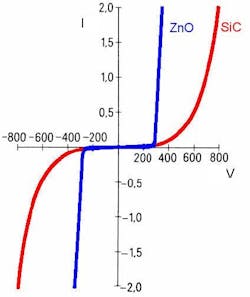Protecting Electric Vehicles from External Transients
What you’ll learn:
- Electrical and cyber vulnerability of EVs during charging.
- The two primary technologies for protecting EVs: isolators and current limiters.
- The four most relevant kinds of current limiters.
Vehicle electrification has made remarkable strides in recent years. But while the charging infrastructure for electric vehicles (EVs) continues to grow, EV charging safety is a question mark. The infrastructure can suffer from poor maintenance and design, as well as, increasingly, from vandalism. Thus, it’s more important than ever that on-board equipment related to external power sources be robust and able to provide protection against unintended or unexpected electrical surges.
The automotive environment is already very demanding in terms of the need to withstand vibration, moisture, EMI, heat, and potentially severe mechanical shocks. At the same time, vehicles are increasingly packed with electronics, fulfilling functional roles and providing comfort and convenience to drivers and passengers. When interfacing with the power grid and the specific characteristics of individual charging stations, EV charging safety must be a priority because there’s the potential for encountering transient electrical characteristics of multiple kinds.
Direct or indirect lightning strikes as well as construction mishaps or traffic accidents are some of the obvious concerns. There can also be surge currents related to sudden load switching, inherent equipment faults, breakers tripping, and resonance in circuits, let alone the potential for coupling between different circuits or elements. (Parallel cables can produce surge pulses that are capacitive, for example.)
All of these factors mean that EV connections to external power sources and many systems within the vehicle that could be impacted by overvoltage from such a source need to be made robust and resistant. Components that can help are primarily isolators and current limiters.
Isolators are Important in High-Voltage Applications
Isolators make it possible to operate high-voltage batteries and equipment in proximity to electronic systems operating at much lower voltage and current levels. Isolators make physical separation more effective by adding electrical barriers that prevent direct current flow between different systems while enabling magnetic or capacitive coupling to deliver needed communication between the two environments.
Isolators, often made from polyimide or ceramic, are a key protective component in battery-management systems (BMS) when external power sources are connected. By preventing electrical interference, they can make sure data on cell conditions and charging is accurate, and they can thereby reduce the risk of thermal runaway.
>>Get the PDF version of this article
Isolators also play a role in DC-DC converters, regenerative braking, and more. In these roles, they help protect against unexpected or unwanted electrical current arriving through external charging sources.
By isolating any fault condition, isolators protect components and maintain safer operations—even a shutdown during a fault condition. Finally, isolators are important to high-voltage interlock systems by making it possible to verify connections are safe and functional, protecting personnel and equipment.
Different Types of Current Limiters
Four of the common current limiting devices or technologies include MOVs, Zener diodes, GDTs, and specialized thyristors
Metal-oxide varistor
The most common type of varistor (e.g., variable resistor) is the metal-oxide varistor (MOV), which usually consists of zinc-oxide grains along with other metal oxides between two metal plates. Diode-like behavior is exhibited between different grains of material. The designed randomness of this diode-like behavior is electrically like a large number of back-to-back diode pairs.
Application of a small voltage allows for only very limited current flows—a product of reverse leakage through the many diode junctions. But when a large voltage is applied, breakdown occurs (through electron tunneling, and even thermionic emissions), and large current can pass through the device. Therefore, the MOV offers high resistance at low voltage and low resistance at high voltages
Zener diodes
There are multiple kinds of transient voltage suppressors (TVSs), each intended to handle sudden overvoltage situations. One of the most common overvoltage protectors is the transient-voltage-suppression diode, or Zener diode, designed to protect electronic devices against overvoltages.
Zeners let current flow "backwards” when a specific reverse voltage, known as the Zener voltage, is encountered (reverse voltage is also referred to as inverted polarity).
Such diodes are designed with a wide range of Zener voltages. Those with a low Zener voltage have a heavily doped p-n junction with a low Zener voltage. In this type of device, reverse conduction happens due to electron quantum tunneling. Diodes with a higher Zener voltage have lighter doped junctions. This means reversal largely occurs from avalanche breakdown. However, both breakdown phenomena are present in all Zeners, including the variable type.
In terms of protecting EVs from transients from external sources, Zeners can help generate low-power stabilized supply voltage derived from higher-voltage sources and can ensure reference voltages. Also, of course, they can contribute to protecting against overvoltages and electrostatic discharge (ESD).
Gas discharge tubes
Gas discharge tubes (GDTs) for circuit protection are small. GDTs typically divert overvoltages to ground. The gas in the tube, selected for the desired electrical characteristics, normally functions as an insulator and has few other design impacts (massive impedance and hardly any capacitance).
However, when a GDT’s sparkover voltage is reached or exceeded, the gas becomes fully ionized and a conductor. The change shunts current surge away from vulnerable circuits and components, helping to ensure EV charger safety.
Thyristor surge protection device
Thyristors are robust and switchable diodes. They can let current flow in one direction but not the other. They typically consist of four layers of alternating P- and N-type materials. In a three-lead thyristor, a small current on its gate lead controls the larger current of the anode-to-cathode path. With a two-lead thyristor, conduction happens based on the potential difference between the anode and cathode. Thyristors keep conducting until the voltage is reverse-biased or removed.
Two examples of thyristor surge protection devices (TSPDs) are the Trisil and the SIDACtor.
Cybersecurity: What is the Vulnerability of EV Charger?
When designing for EV charging safety involving circuits that interface with systems outside the vehicle, one additional consideration is cybersecurity. To date, there have only been a handful of occasions where charging infrastructure was involved with a cybersecurity issue, but experts believe the potential exists.
In the U.S., little has been done to address this concern, but the EU’s NIS2 directive aimed at ensuring IoT security would likely apply to charging stations as well. It also could be a starting point for building in security and resilience. Though power circuits aren’t typically an issue, many charging stations share payment and identity data, and these connections to the vehicle could potentially compromise safety (see figure).
>>Get the PDF version of this article
About the Author



